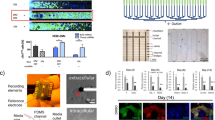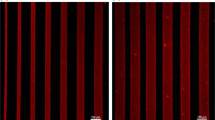Abstract
Chick embryonic heart has recently been utilized as a model to create a micromass (MM) culturing system. The aim was to overcome the ethical barriers arising from testing the embryotoxicity of chemicals using human embryonic cells. The system represents a valuable tool to study the ability of chemicals to interfere with various embryonic developmental processes such as cellular communication, differentiation, cellular activity, and proliferation, where the disturbance any of them could result in maldevelopment. The system can also be utilized to investigate ROS production and expression of several transmembrane proteins to study their roles in chemical-induced teratogenicity or embryotoxicity.
Access this chapter
Tax calculation will be finalised at checkout
Purchases are for personal use only
Similar content being viewed by others
References
Flint OP, Orton TC (1984) An in vitro assay for teratogens with cultures of rat embryo midbrain and limb bud cells. Toxicol Appl Pharmacol 76(2):383–395
Doyle D, Kapron CM (2002) Inhibition of cell differentiation by manganese chloride in micromass cultures of mouse embryonic limb bud cells. Toxicol In Vitro 16(2):101–106
Parsons JF, Rockley J, Richold M (1990) In vitro micromass teratogen test: Interpretation of results from a blind trial of 25 compounds using three separate criteria. Toxicol In Vitro 4(4–5):609–611
Hurst HS, Clothier RH, Pratten M (2007) An evaluation of a novel chick cardiomyocyte micromass culture assay with two teratogens/embryotoxins associated with heart defects. Altern Lab Anim 35(5):505–514
Hurst H, Clothier RH, Pratten M (2009) An evaluation of the chick cardiomyocyte micromass system for identification of teratogens in a blind trial. Reprod Toxicol 28(4):503–510. https://doi.org/10.1016/j.reprotox.2009.07.003
Piersma AH (2006) Alternative methods for developmental toxicity testing. Basic Clin Pharmacol Toxicol 98:427–431
Faustman EM (1988) Short-term tests for teratogens. Mutat Res 205(1–4):355–384
Castoldi AF, Johansson C, Onishchenko N, Coccini T, Roda E, Vahter M, Ceccatelli S, Manzo L (2008) Human developmental neurotoxicity of methylmercury: impact of variables and risk modifiers. Regul Toxicol Pharmacol 51(2):201–214. https://doi.org/10.1016/j.yrtph.2008.01.016
Harris C, Hansen JM (eds) (2012) Methods in molecular biology. Developmental toxicology methods and protocols. Springer Science+Business Media, New York Dordrecht Heidelberg London. https://doi.org/10.1007/978-1-61779-867-2
Talpur AD, Ikhwanuddin M, Ambok Bolong A-M (2013) Nutritional effects of ginger (Zingiber officinale Roscoe) on immune response of Asian sea bass, Lates calcarifer (Bloch) and disease resistance against Vibrio harveyi. Aquaculture 400-401:46–52. https://doi.org/10.1016/j.aquaculture.2013.02.043
Tiran D (2012) Ginger to reduce nausea and vomiting during pregnancy: evidence of effectiveness is not the same as proof of safety. Complement Ther Clin Pract 18(1):22–25. https://doi.org/10.1016/j.ctcp.2011.08.007
Viljoen E, Visser J, Koen N, Musekiwa A (2014) A systematic review and meta-analysis of the effect and safety of ginger in the treatment of pregnancy-associated nausea and vomiting. Nutr J 13:20. https://doi.org/10.1186/1475-2891-13-20
Wilkinson JM (2000) What do we know about herbal morning sickness treatments? A literature survey. Midwifery 16:224–228
Jacobsgaard H (2008) The pharmacists request that pregnant women consult physicians prior to GraviFrisk [article in Danish]. Ugeskr Laeger 170(10):876
Wang S, Zhang C, Yang G, Yang Y (2014) Biological properties of 6-gingerol: a brief review. Nat Prod Commun 9(7):1027–1030
Ali BH, Blunden G, Tanira MO, Nemmar A (2008) Some phytochemical, pharmacological and toxicological properties of ginger (Zingiber officinale Roscoe): a review of recent research. Food Chem Toxicol 46(2):409–420. https://doi.org/10.1016/j.fct.2007.09.085
Abdel-Aziz H, Windeck T, Ploch M, Verspohl EJ (2006) Mode of action of gingerols and shogaols on 5-HT3 receptors: binding studies, cation uptake by the receptor channel and contraction of isolated guinea-pig ileum. Eur J Pharmacol 530(1–2):136–143. https://doi.org/10.1016/j.ejphar.2005.10.049
Lien HC, Sun WM, Chen YH, Kim H, Hasler W, Owyang C (2003) Effects of ginger on motion sickness and gastric slow-wave dysrhythmias induced by circular vection. Am J Physiol Gastrointest Liver Physiol 284(3):G481–G489. https://doi.org/10.1152/ajpgi.00164.2002
Pertz HH, Lehmann J, Roth-Ehrang R, Elz S (2011) Effects of ginger constituents on the gastrointestinal tract: role of cholinergic M3 and serotonergic 5-HT3 and 5-HT4 receptors. Planta Med 77(10):973–978. https://doi.org/10.1055/s-0030-1270747
Pongrojpaw D, Somprasit C, Chanthasenanont A (2007) A randomized comparison of ginger and dimenhydrinate in the treatment of nausea and vomiting in pregnancy. J Med Assoc Thail 90(9):1703–1709
Kim EC, Min JK, Kim TY, Lee SJ, Yang HO, Han S, Kim YM, Kwon YG (2005) [6]-Gingerol, a pungent ingredient of ginger, inhibits angiogenesis in vitro and in vivo. Biochem Biophys Res Commun 335(2):300–308. https://doi.org/10.1016/j.bbrc.2005.07.076
Susan E (2007) Apoptosis: a review of programmed cell death. Toxicol Pathol 35(4):495–516
Chakraborty D, Bishayee K, Ghosh S, Biswas R, Mandal SK, Khuda-Bukhsh AR (2012) [6]-Gingerol induces caspase 3 dependent apoptosis and autophagy in cancer cells: drug-DNA interaction and expression of certain signal genes in HeLa cells. Eur J Pharmacol 694(1–3):20–29. https://doi.org/10.1016/j.ejphar.2012.08.001
Yang G, Zhong L, Jiang L, Geng C, Cao J, Sun X, Ma Y (2010) Genotoxic effect of 6-gingerol on human hepatoma G2 cells. Chem Biol Interact 185(1):12–17. https://doi.org/10.1016/j.cbi.2010.02.017
Lee HS, Seo EY, Kang NE, Kim WK (2008) [6]-Gingerol inhibits metastasis of MDA-MB-231 human breast cancer cells. J Nutr Biochem 19(5):313–319. https://doi.org/10.1016/j.jnutbio.2007.05.008
Lin CB, Lin CC, Tsay GJ (2012) 6-Gingerol Inhibits Growth of Colon Cancer Cell LoVo via Induction of G2/M Arrest. eCAM 2012:326096. https://doi.org/10.1155/2012/326096
Heitmann K, Nordeng H, Holst L (2013) Safety of ginger use in pregnancy: results from a large population-based cohort study. Eur J Clin Pharmacol 69(2):269–277. https://doi.org/10.1007/s00228-012-1331-5
Portnoi G, Chng LA, Karimi-Tabesh L, Koren G, Tan MP, Einarson A (2003) Prospective comparative study of the safety and effectiveness of ginger for the treatment of nausea and vomiting in pregnancy. Am J Obstet Gynecol 189(5):1374–1377
Leung KW, Wong AS (2013) Ginseng and male reproductive function. Spermatogenesis 3(3):e26391. https://doi.org/10.4161/spmg.26391
Poindexter BJ, Allison AW, Bick RJ, Dasgupta A (2006) Ginseng: cardiotonic in adult rat cardiomyocytes, cardiotoxic in neonatal rat cardiomyocytes. Life Sci 79(25):2337–2344. https://doi.org/10.1016/j.lfs.2006.07.038
Jiang R, Dong J, Li X, Du F, Jia W, Xu F, Wang F, Yang J, Niu W, Li C (2015) Molecular mechanisms governing different pharmacokinetics of ginsenosides and potential for ginsenoside-perpetrated herb-drug interactions on OATP1B3. Br J Pharmacol 172(4):1059–1073. https://doi.org/10.1111/bph.12971
Xie CL, Wang WW, Xue XD, Zhang SF, Gan J, Liu ZG (2015) A systematic review and meta-analysis of Ginsenoside-Rg1 (G-Rg1) in experimental ischemic stroke. Sci Rep 5:7790. https://doi.org/10.1038/srep07790
Lu JM, Yao Q, Chen C (2009) Ginseng compounds: an update on their molecular mechanisms and medical applications. Curr Vasc Pharmacol 7(3):293–302
Karmazyn M, Moey M, Gan XT (2011) Therapeutic potential of ginseng in the management of cardiovascular disorders. Drugs 71(15):1989–2008. https://doi.org/10.2165/11594300-000000000-00000
Liu P, Yin H, Xu Y, Zhang Z, Chen K, Li Y (2006) Effects of ginsenoside Rg1 on postimplantation rat and mouse embryos cultured in vitro. Toxicol In Vitro 20(2):234–238. https://doi.org/10.1016/j.tiv.2005.06.029
Pratten M, Ahir BK, Smith-Hurst H, Memon S, Mutch P, Cumberland P (2012) Primary cell and micromass culture in assessing developmental toxicity. Methods Mol Biol 889:115–146. https://doi.org/10.1007/978-1-61779-867-2_9
Rumbold A, Crowther CA (2005) Vitamin C supplementation in pregnancy. Cochrane Database Syst Rev (2):CD004072. https://doi.org/10.1002/14651858.CD004072.pub2
Heller M, Burd L (2014) Review of ethanol dispersion, distribution, and elimination from the fetal compartment. Birth Defects Res A Clin Mol Teratol 100(4):277–283. https://doi.org/10.1002/bdra.23232
Garle MJ, Knight A, Downing AT, Jassi KL, Clothier RH, Fry JR (2000) Stimulation of dichlorofluorescin oxidation by capsaicin and analogues in RAW 264 monocyte/macrophages: lack of involvement of the vanilloid receptor. Biochem Pharmacol 59(5):563–572
Lee MN, Lee SH, Lee MY, Kim YH, Park JH, Ryu JM, Yun SP, Lee YJ, Kim MO, Park K, Han HJ (2008) Effect of dihydrotestosterone on mouse embryonic stem cells exposed to H2O2-induced oxidative stress. J Vet Sci 9(3):247–256
Lowry OH, Rosebrough NJ, Farr AL, Randall RJ (1951) Protein measurement with the Folin phenol reagent. J Biol Chem 193(1):265–275
Author information
Authors and Affiliations
Corresponding author
Editor information
Editors and Affiliations
Rights and permissions
Copyright information
© 2019 Springer Science+Business Media, LLC, part of Springer Nature
About this protocol
Cite this protocol
Mohammed, O.J., Pratten, M.K. (2019). Micromass Methods for the Evaluation of Developmental Toxicants. In: Hansen, J., Winn, L. (eds) Developmental Toxicology. Methods in Molecular Biology, vol 1965. Humana, New York, NY. https://doi.org/10.1007/978-1-4939-9182-2_5
Download citation
DOI: https://doi.org/10.1007/978-1-4939-9182-2_5
Published:
Publisher Name: Humana, New York, NY
Print ISBN: 978-1-4939-9181-5
Online ISBN: 978-1-4939-9182-2
eBook Packages: Springer Protocols




